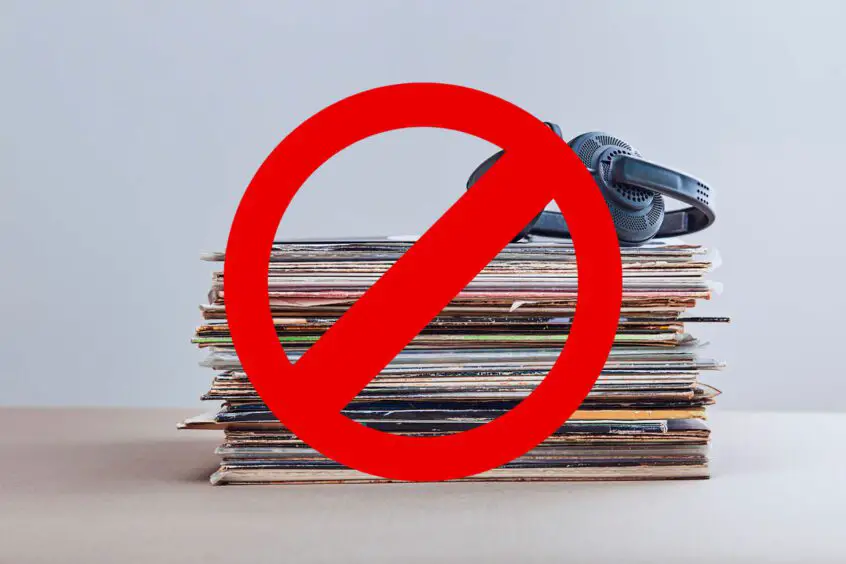When storing your vinyl records, it can be tempting to stack them in horizontal piles. This could be to save space, or perhaps you just like the idea of a convenient stack somewhere near your turntable.
There are several different reasons why you shouldn’t store records horizontally and why it’s better for the longevity of your collection to store them vertically.
Horizontal Record Storage – What’s the Problem?
You should avoid storing vinyl records in flat, horizontal piles as the downward pressure can cause the disk to warp over time and contribute to scuffs or scratches on the record surface.
For records at the bottom of a large pile, the weight and pressure are significant, and because record labels protrude slightly from the surface, this pressure can make the record “bow” over time.
If there are any dirt particles on the record surface, the heavy pressure of horizontal stacking can also push the unwanted particles against the grooves, risking scratches.
In extreme cases, excessive weight could even cause a record to crack. In short, your records should only be horizontal when they’re on the turntable.
Horizontal Record Storage is Bad for the Outer Sleeves:
The same pressure that can damage your records will, over time, also damage the outer sleeve and artwork. You will notice ring wear or misshaping of the outer record jacked more frequently on records stored horizontally. (Ring wear is a phenomenon where circular wearing of the outer sleeve occurs where the record lies underneath).

Why Storing Records Vertically is Best
Storing your records vertically dramatically reduces the risk of damage and makes browsing more convenient.
Providing the records aren’t leaning excessively on each other, the pressure and weight issues of horizontal vinyl record stacking is non-existent.
If you have a large collection, it’s best to choose record storage cabinets with lots of small compartments, which effectively break your collection into smaller sub-sections.
Additional Benefits of Stacking Records Vertically:
Easier Browsing & Record Selection: Choosing the next record to spin on your deck is much easier when you can simply flick through shelves or record crates filled with vertically stacked records. No need to pick up entire piles or attempt to pull a record out precariously from lower down the stack.
Even better, you can now easily organize your collection alphabetically or with additional sub-genres. Choosing a record becomes easier and more pleasurable.
Better Airflow: Heavy pressure can trap moisture between records over time and lead to mold buildup. Records stacked vertically have better airflow between them, which can help reduce pesky mold and mildew.
If you live in a very humid climate, you can help reduce the potential for mold problems further by using humidity indicator cards (HIC) and moisture-absorbing desiccant cards.
Can I Store a Small Collection of Records Horizontally?
While the issues of weight and pressure clearly increase with larger collections, I would advise erring on the side of caution and avoid horizontal storage for all collections great and small.
How Do Records Warp?
Records, which are made using polyvinyl chloride (PVC) can warp if exposed to excessive pressure, heat, or direct sunlight.
So, the very forces that made your record in the first place (heat and pressure) can also bend the record out of shape. If a record is left in extreme conditions, say in direct sunlight or a hot car, warping can happen very quickly indeed!
Once this happens, it is extremely difficult (and often impossible) to fix. Collectors have (over the years) contrived many DIY methods designed to “fix” a warped record, including placing the record between two sheets of glass and then applying heat using a conventional home oven, but this is fraught with risk.
More specialist products, such as the aptly named “Vinyl Flat” are a safer option where the heat is applied gently and more consistently using a purpose-designed “vinyl flattener” product.
Horizontal vs Vertical Record Storage – The Bottom Line:
Ensuring your records are stored vertically will go a long way toward protecting them for the long term.
Adding good quality inner sleeves and protective outer record sleeves and ensuring your records are housed in a safe storage unit will protect them further.
Record care doesn’t have to be rocket science, but following a few simple best practices will ensure your collection last for years and generations to come. For more record storage advice, check out our full guide to storing records safely.



